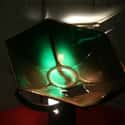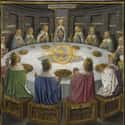-
(#1) A Pair Of Historians Claim The Holy Grail Was Hidden In Plain Sight In Spain
In their 2014 book, Kings of the Grail: Tracing the History of the Holy Grail, historians Margarita Torres and Jose Miguel Ortega del Rio claimed they'd found the Holy Grail - and that it had been right there in front of observers all along. According to Torres and del Rio, the chalice of the Infanta Doña Urraca, located at the Basilica of San Isidoro in León and on display for decades, was the coveted artifact.
Torres and del Rio based their assertions on an Egyptian manuscript that described how the Holy Grail had been transported from Jerusalem to Cairo, only to then find its way to Islamic Spain as a payment to a local emir. From there, the chalice was given as a gift to King Ferdinand I of León (b. c. 1015), later making its way to the same basilica where the king was buried in 1065.
The chalice bears the name of Ferdinand's daughter, Urraca of Zamora, and was made out of two goblets crafted into one. In support of Torres and de Rio's claim, scientists determined the chalice - made from agate, gold, and onyx and decorated with precious gems - dates to sometime between the third century BCE and the fist century CE.
In the words of del Rio, "the only chalice that could be considered the chalice of Christ is that which made the journey to Cairo and then from Cairo to León - and that is this chalice."
-
(#2) The 2014 Discovery Isn’t The Only Time Someone Claimed They Found The Holy Grail
Torres and del Rio weren't the first historians to insist they'd solved the mystery of the Holy Grail. As early as 12th century, poets and writers have described, mentioned, and even claimed to know the whereabouts of the Grail. The locations of hundreds of Holy Grails span the globe, with references to grails in Canada and Scotland, taken there by members of the Knights Templar.
In Wales, the Nanteos Cup was believed to have been the Holy Grail, while numerous sites in Spain, France, and England hold on to some sort of connection with the chalice. During the 20th century, the Antioch Chalice, made of silver with elaborate decoration, was identified as the Holy Grail, only to be debunked later as sixth-century artifact.
-
(#3) Researchers Proved The Chalice Of Mary Magdalene Was 2,000 Years Old
The chalice of Mary Magdalene is believed to have been used by Jesus's devotee to collect his blood while he perished on the cross. The Marian Chalice, made of green alabaster, dates to the first century CE.
Author Graham Phillips rejects the idea that the Marian Chalice, a vessel resembles a small jar that would have been used to hold perfume or ointment, was used by Jesus. Rather, it's been conflated or mixed up with the Holy Grail. In Phillip's opinion, the Holy Grail is the Gospel of Thomas, secret Christian scripture discovered in 1945.
In Phillip's theory, the chalice of Mary Magdalene was taken to Britain during the fifth century CE and later came into the possession of Fulk Fitz Warine. In other versions, the Holy Grail is actually the Hawkstone Grail, a cup later found in Hawkstone Park by the Fitz Warine family and hidden at their Whittington Castle. This is, perhaps, how the Marian Chalice and the Hawkstone Grail were linked in Holy Grail tradition.
It's also entirely possible they are one and the same, since Fitz Warine family descendent Thomas Write claimed to have the Grail during the 1800s. What he described, however, was more akin to Mary's scent jar. Factor in analogous language referring to wine as blood and the connections unclear.
-
(#4) Some Believe The Holy Chalice Of Valencia Is The Mythical Holy Grail
The Santo Cáliz, or Holy Chalice, of Valencia in Spain, perhaps the best recognized possible Holy Grail, traces its origins to the first century BCE. Made out of gold and agate, the Holy Chalice of Valencia, believed to have been used at the Last Supper by Jesus, was taken to Rome by Saint Peter during the first century CE.
With the papacy under threat, the chalice was transferred to Huesca, Spain, during the third century CE, hidden in the Pyrenees during the Islamic invasions of the Middle Ages, and, according to records, made its way to the monastery at San Juan de la Peña by 1071 CE.
Documented among King Martin of Aragon's royal possessions in 1399, the chalice was moved to Valencia in 1416. During subsequent centuries, the Holy Chalice went in and out of hiding in Spain until finally arriving back at the Valencia Cathedral in 1939.
Currently, the Christian faithful can see the Holy Chalice of Valencia twice a year when it's brought out for public viewing.
Scholars continue to advocate for the Valencia chalice as the real Holy Grail. In 2019, art historian Ana Mafé García stated its composition, "represents the tribe of Judah, of which Jesus of Nazareth was also a member."
-
(#5) The Genoa Chalice Is Another Possible Contender For The Grail
Made of glass and hexagonal in shape, the Sacro Catino, also known as the Genoa Chalice, is said to have been made in Egypt. It was taken to Jerusalem by the Queen of Sheba and moved to the coastal site of Caesarea at some point before the 11th century.
In the aftermath of the First Crusade, Guglielmo Embriaco took the vessel to Genoa. William of Tyre, writing during the 12th century, described the chalice as more of, "a vase of brilliant green shaped like a bowl. The Genoese, believing that it was of emerald, took it in lieu of a large sum of money and thus acquired a splendid ornament for their church."
Tradition around the glass dish grew and, by the 13th century, it was definitively identified as one of the items used at the Last Supper. From there, it became part of the story of Jesus on the cross, with stories about Nicodemus, who helped Joseph of Arimathea bury Jesus, using it to collect Jesus's blood.
Napoleon took the relic to Paris during the early 19th century, where it was discovered that it was made of glass rather than emerald.
-
(#6) The Holy Grail Isn’t Mentioned By Name In The Bible
While no so-called Holy Grail receives mention in the Bible, there are numerous references to cups and drinking vessels throughout the New Testament. Many of these remain at the core of arguments about the importance and sanctity of the Grail.
For example, Luke 22:20 describes Jesus drinking at the Last Supper, telling his followers, "This cup is the new covenant in my blood, which is poured out for you. Mark 15:23 recounts how, while on the Cross, spectators, "offered him wine mixed with myrrh, but he did not take it," presumably from a cup.
While biblical mention of Holy Grail-like objects can support its existence, the lack of description and specificity adds little to helping identify what a real grail would have looked like.
-
(#7) The Holy Grail Wasn’t Even Named Until The 12th Century
The first use of the term grail comes from 12th century French romance poet, Chrétien de Troyes. In his work, Perceval or the Story of the Grail, dating to c. 1190 CE, Chrétien de Troyes references "un graal," an object that continues to spark curiosity. Chrétien passed before he completed the work, adding to the mystery of what he meant and to what he referred.
Chrétien's grail was some sort of platter or serving dish, but the mere mention of it prompted a whole school of grail literature. Soon, the grail became the chalice used by Jesus at the Last Supper or the cup that captured Jesus's blood as he perished on the cross. Later tellings would go further, presenting the Holy Grail as a person - someone from Jesus's bloodline - or some sort of supernatural force.
Notably, Robert de Boron, writing around 1200 CE, incorporated Joseph of Arimathea into his work, linking the Holy Grail directly to the crucifixion of Jesus. Joseph, tasked with Jesus's burial, was said to have used the grail from the Last Supper to collect Jesus's blood, blending several traditions into one.
-
(#8) Sites In England Are Commonly Associated With The Grail Due To Its Arthurian Connections
Chrétien de Troyes (c. 1190 CE) gave the world Perceval, a knight on a quest for the grail. After Chrétien's passing, authors like Robert de Boron (c. 1200 CE) brought the grail to Britain, with the former placing it into the hands of Joseph of Arimathea. In Joseph d'Arimathie, Arimathea buries the grail in a secret location, a site that dominates the quests of King Arthur and his Knights of the Round Table.
Legendarily, Joseph of Arimathea founded Glastonbury Abbey in the south of Britain, home to the Chalice Well where the Holy Grail is supposed to have been hidden. As a result, the entire area has been associated with Arthurian lore. Avalon (King Arthur's burial site) accompanies Cadbury Castle (allegedly Camelot) as locations that have links to the Holy Grail, but so does Tintagel Castle in Cornwall, where King Arthur was said to have been conceived.
As centuries of Arthurian prose and poems developed, the Holy Grail continued to find life. Sir Thomas Malory's Morte Darthur, a 15th century work, not only synthesizes earlier Arthurian traditions, but also gives the Holy Grail a voice, one that leads Sir Lancelot to the a chamber where he:
Saw a table of silver and the Holy Vessel, covered with red samite, and many angels about it, whereof one held a candle of wax burning and the other held a cross and the ornaments of an altar.
-
(#9) Some Historians Claim The Holy Grail Never Existed
Because there is no actual evidence that the Holy Grail ever existed, many scholars doubt it is anything more than creation of human imagination. Never present in Scripture or mentioned by any religious authority, the Holy Grail has its foundations in literature, growing in history and lore since the 12th century. According to historian Carlos de Ayala, "You cannot search for something that does not exist."
That said, the lack of a physical Holy Grail doesn't make it any less real in many ways. As the Holy Grail has developed over time, artwork, language, and cultural connections to the idea of its existence have inspired countless individuals throughout the ages. By giving the Holy Grail meaning, form, and significance, it remains symbolic of divine and personal quests alike.
-
(#10) The Holy Grail Mystery Might Never Be Solved
Investigation into the Holy Grail - its origins, location, and manifestation - continue to take place. With the term "Holy Grail" indicating something unattainable, or at the very least, difficult to behold or possess, it is entirely possible that the mystery will never come to an end.
New theories, interpretations, and presentations of the Holy Grail legend add complexity to claims made by historians Margarita Torres and José Ortega del Rio in 2014. They also represent the unending efforts to locate the Holy Grail.
Alongside historians and archaeologists, fiction writers like Grigor Fedan and Dan Brown, entertainers and Hollywood executives, and artists find no agreement about the Holy Grail - but there's no general acceptance that the search for it has run its course either.
New Random Displays Display All By Ranking
About This Tool
According to historical legend, the Holy Grail was a wine cup used at the dinner with the 11 disciples before the crucifixion. Jesus once took up this cup and ordered the disciples to drink the red wine that symbolizes his blood in it, thereby creating a memorial ceremony for the Passion. Some people think that the Holy Grail has magical power because of this sacred special occasion.
Many legends believe that if you can find the Holy Grail and drink the water with it, you will rejuvenate, resurrect, and gain immortality. This legend has been widely extended to many literary works, movies, and games. The random tool explained 10 mysteries and controversies of the Holy Grail.
Our data comes from Ranker, If you want to participate in the ranking of items displayed on this page, please click here.




















